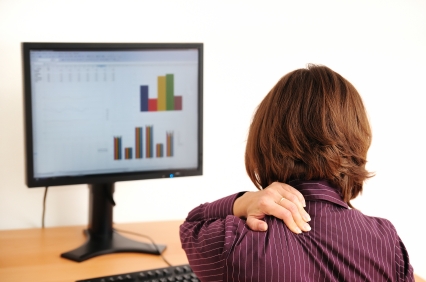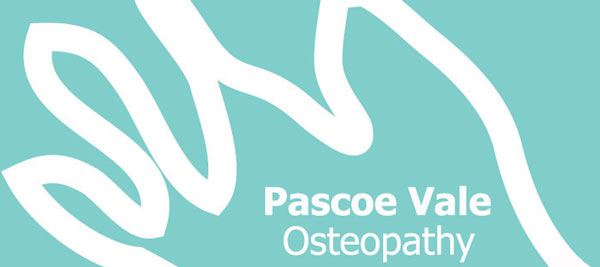‘Office Worker’ Shoulders
Written by Dr. David Howard – B.Sc. (Clinical Sci.), M.H.Sc. (Osteopathy), B.App.Sc (Human Movement) from Pascoe Vale Osteopathy located in Pascoe Vale, Melbourne, Victoria, Australia.
Sitting at a desk and tapping away on a computer all day is not what our bodies are designed to do. A large number of my patients suffer from ‘complaints of the arm, neck and/or shoulder’ – also known as CANS. This is a musculoskeletal condition that is not caused by acute trauma or any systemic disease, just by poor sitting posture. Interestingly, computer workers more often experience pain in the neck and shoulders than the hands and forearms. This is unexpected as the muscles used to type and control the mouse are predominantly in the hands and forearm.
CANS causes pain across the shoulders and often up the side of the neck. In more severe cases, the patient can experience headaches, numbness, tingling, pins and needles in the arms.
The position of an office worker’s poor posture is most commonly slumped with the head positioned forward and the shoulders rolled in. This anterior, or forward, position of the neck puts a huge amount of extra stress on the muscles of the shoulders and neck causing them to become overloaded, tight and painful.
Some of the nerves and blood vessels that supply the arm exit the neck by passing through the neck muscles, under the clavicle (collar bone), under the pec (chest) muscles, through the arm pit and into the arm. The muscles that are predominantly affected by poor sitting posture are the ones that this bundle of nerves and blood vessels pass through. The pressure of the tight muscles onto the nerves causes tingling and numbness, the pressure onto blood vessels effects blood supply to the arm causing pins and needles or makes the arm “go to sleep”.
The research into this common condition informs us that there are several other factors that influence the pain experienced by patients. Things such as high stress levels, inflexible work ergonomics, and having no/limited breaks at work all increase the likelihood of experiencing the symptoms outlined above.
Interestingly, women experience CANS more often and to a greater degree then their male co-workers in exactly the same conditions. In a year, 51% of male computer workers experience CANS verses 72% of women. The research suggests that the reasons behind this discrepancy include differences between the male and female body, that women tend to work without a break for longer than men, and due to the higher likelihood of extra stress on women from running a household and taking on childcare duties in addition to their work stressors.
What can you do about it?
There are several things that you can do to prevent and manage CANS.
Make sure that your desk is set up properly. Your computer screen and keyboard should be directly in front of you. The top of the computer screen should be in line with your eye level (this is why laptops with their low position are not ideal!). You should position the items on your desk so that you are not reaching too far for anything (i.e. phone).
Make sure you are sitting properly. Your butt should be right up against the back of the chair as you can’t slump in this position. Your arms should be hanging at your side with your elbows at 90 degrees. The wrists should be straight. Both feet should be flat on the floor. This position may feel quite uncomfortable to begin with because your body is likely to be ‘stuck’/used to your previous poor posturing. You may need to work up to sitting properly for long periods gradually.
Get semi-regular treatment with an osteopath! If you can’t quit your job, you need to regularly “service” your body – just like your car – to decrease your symptoms or to prevent them from developing. How often you need “servicing” depends on your body and work stressors – you may need treatment every fortnight or once every 2-3 months, everyone is different.
Stretch – regularly! There are some recommended stretches below. These can decrease the tension in the muscles. I have patients that have an alarm set on their computers to remind them to have a short break and stretch every hour, but even twice a day will do for most people.
Torso Stretch
Seated or standing, lace the fingers together and stretch them up towards the ceiling. Stretch up as high as you can and lean back slightly over the back of your chair. Hold for 15 seconds.
Shoulder shrugs
Seated or standing, lift the shoulders up towards the ears, squeezing them lightly. Hold for 1-2 seconds and roll them back as you relax down. Repeat for 8-10 repetitions.
Neck stretch
Sitting in your chair, reach down and lightly grip the side of the seat of the chair with the right hand and gently pull up whilst taking your left ear to the left shoulder, feeling a stretch down the right side of the neck and shoulder. Then, slightly rotate your neck so that your nose is pointing towards your left armpit. Hold for 30 seconds and repeat on the other side.
Upper back stretch
Seated or standing, stretch the arms straight out and rotate the hands so that the palms face away from each other. Cross the arms so that the palms are pressed together, contract the abs and round the back, reaching away as you relax the head. Don’t collapse but instead imagine you’re curving up and over an imaginary ball. Hold the stretch for 30 seconds. If twisting the arms doesn’t feel good, simply lace the fingers together.
Disclaimer: Information provided in this post is of a general nature and should not be used solely in place of individual advice from either myself or another medical professional. Pascoe Vale Osteopathy and Dr. David Howard will not take responsibility for any injury resulting from following information in this post.
Pascoe Vale Osteopathy provides osteopathic services to patients from a wide number of suburbs such as Pascoe Vale, Essendon, Essendon North, Moonee Ponds, Strathmore, Niddrie, Keilor, Coburg, Brunswick, Oak Park, Glenroy, Airport West, Travancore, Melbourne, Australia.
